How to make Manhattan-style Fermented Pickles with Garlic and Dill! An easy step-by-step guide to making the most flavorful, crunchy, tangy pickles full of healthy probiotics with only 20 minutes of hands-on time! The pickle brine is like a “tonic” -drink a shot daily to support a healthy gut! Video.
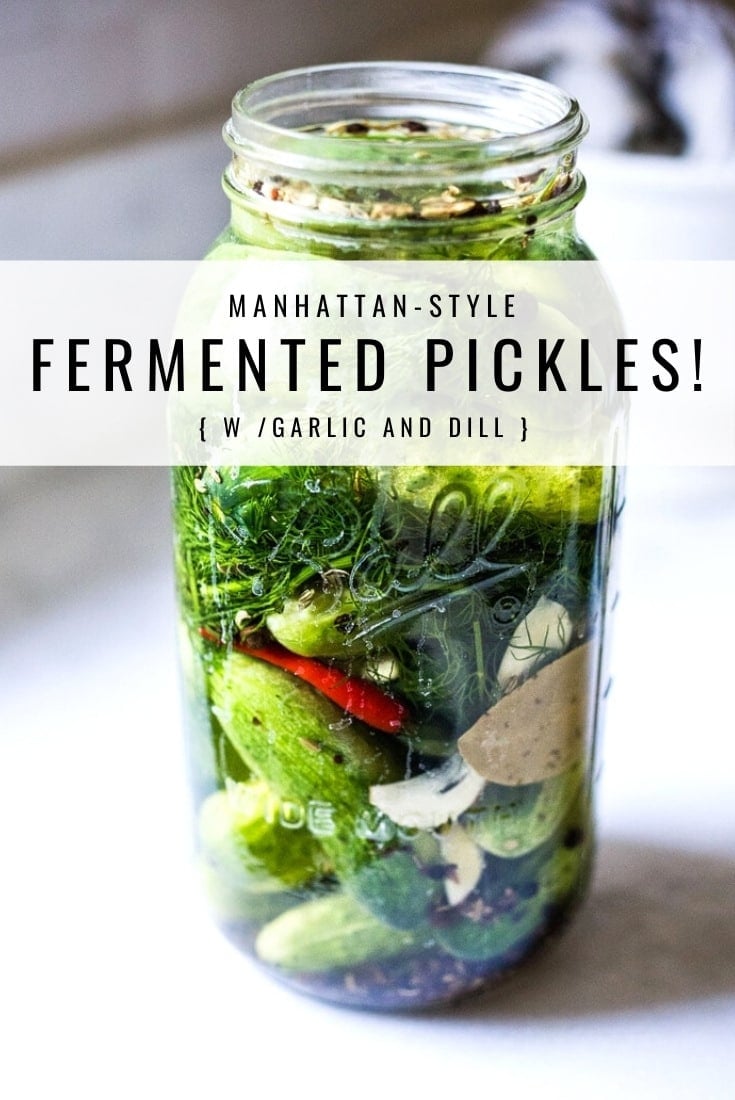
What happens when people open their hearts? They get better. ~Haruki Murakami
I’m excited to share this easy recipe for Fermented Pickles with you! If you are a crunchy pickle lover like me, you will be in heaven. Seriously, these are the best! These Manhattan-style “half-sour” fermented dill pickles are crispy, crunchy, flavorful, and oh-so alive!
Fermented in a salt brine, rather than vinegar, they get their delicious tanginess from light fermentation rather than vinegar.
Full of healthy, gut-healing, immunity-boosting probiotics these little guys are perfect as a low-calorie snack, or sliced and added to sandwiches or served as a tasty side.
Not only are they delicious and incredibly EASY to make, they are also incredibly good for us!
And as crazy as this may sound to some, the fizzy brine itself is like a healing tonic to me – I love to drink a shot of it- especially when I feel like my immunity needs a boost! So flavorful and totally energizing. Or try a Gin and Brine!
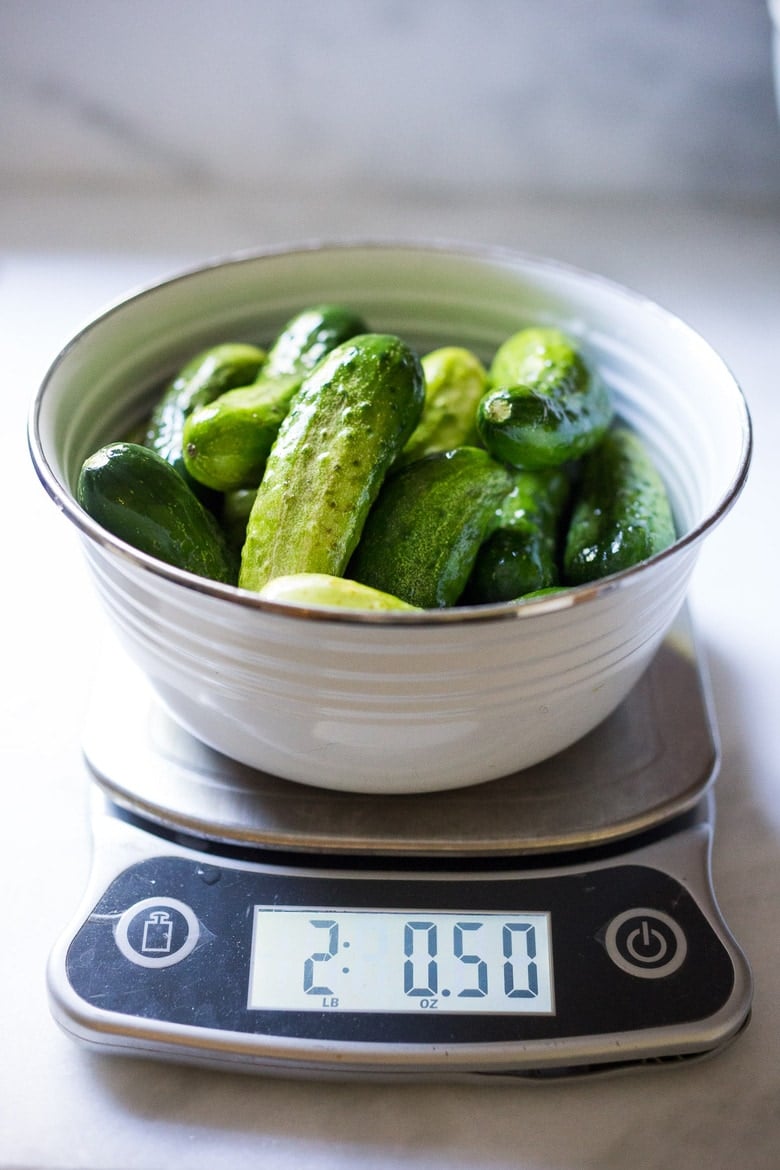
What you’ll need
- Pickling Cucumbers- Small and short (4 inches long) with thin bumpy skin, crisp texture, small seeds, a blocky shape and color gradient from light to dark. Varieties include Kirby, Calypso, Royal, Pickalot, National Picking, Adam Gherkin, Sassy, Eurika, Jackson, Boston Pickling, Northern Pickling… to name a few. You’ll need 2 lbs of “pickling cucumbers.” This recipe makes one large 1/2 gallon jar (or use two quart-sized jars) – a relatively small batch. Pickling cucumbers are most easily found at your local farmers’ market. Ask the farmers if they have “pickling cucumbers” they can help direct you to the right ones. Your pickles will only be as good as your cucumbers, so choose wisely! Make sure they are roughly the same size -about 4 inches long with 1 1/2-inch to 2-inch diameters – so they fit in the jar nicely and ferment at the same rate. I handpicked each one. They should be fresh and crisp with no soft spots.
- Salt-use fine sea salt, or fine Himalayan Pink salt
- Garlic and Onion – we load this up with 10-20 garlic cloves for the best flavor!
- Fresh Dill – use a big handful!
- Spices: Ground Turmeric ( adds fresh flavor) fennel seeds, mustard seeds, whole peppercorns, coriander seeds, whole allspice, dill seeds and celery seeds. Feel free to change or embellish! I added a couple of chilies for a little heat.
- Optional Tannic Acid: Bay leaves, grape leaves, oak leaves, or a couple of slices of fresh horseradish root. Cucumbers contain enzymes that soften them. To prevent this add a few bay leaves or a grape leaf to the jar.
- Two-Quart Mason Jar ( 8 cup mason jar)
- Fermentation weights
- Optional: Air lock, gasket, metal ring
How long does it take to ferment pickles?
These 3% Brined, half-sour crunchy pickles take 3-5 days of fermenting time.
The Brine: SALT TO WATER RATIO
- This recipe is a 3% salt water brine, which is considered “safe”. It equals 7 grams of salt per 1 cup of water. Or, 1 heaping teaspoon salt (1 1/4 teaspoon salt ) per 1 cup of water. This ratio allows one to drink the brine (like a shot) because it is not too salty and is designed for a shorter fermentation period ( 3-5 days). Crunchy, lightly fermented pickles!
- If you want a stronger brine for a longer ferment, feel free to go up to 4.5%. So for example, 3.5% Ratio= 9 grams of salt per 1 cup of water, 4.5% brine =10.8 grams of salt per 1 cup of water. For a 4.5% brine, half-sour pickles take 5-7 days, full sour pickles 14-21 days.
Fermented Pickles (step-by-step Instructions)
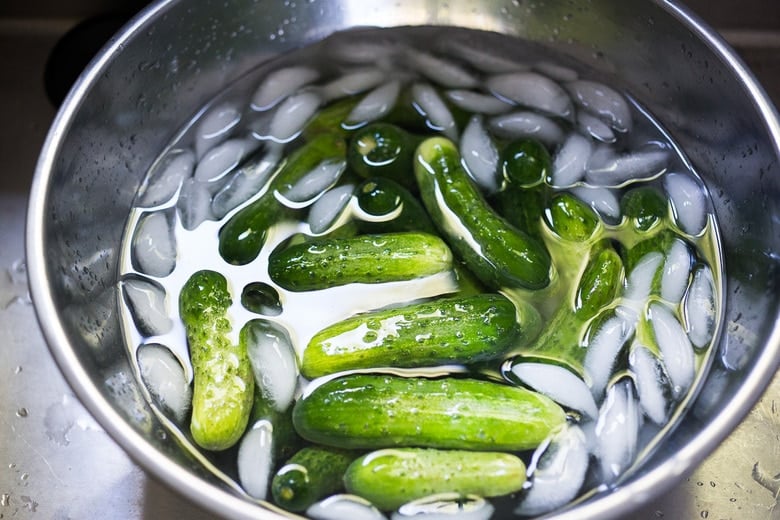
Step 1: Wash the cucumbers, slice off 1/16 inch of the blossom end, and soak them in an ice bath for 15-30 minutes to firm and crisp them up. There are enzymes in the blossom end that can make your pickles soft, so be sure to remove them.
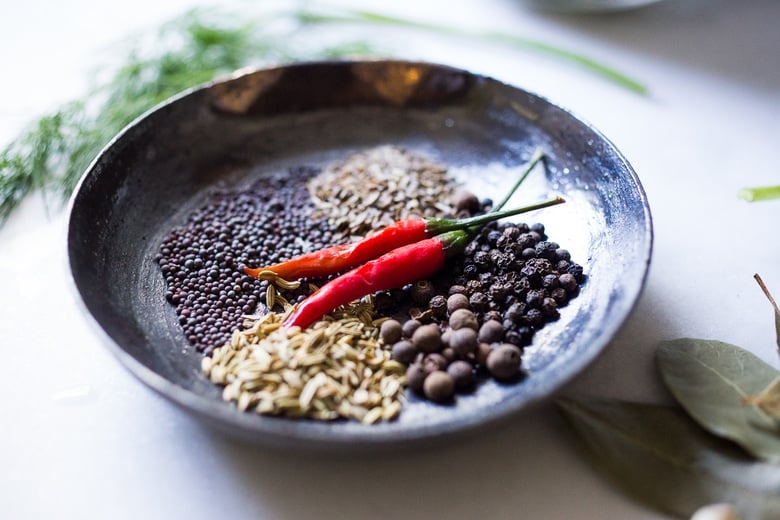
Step 2: Slice the garlic lengthwise and gather your spices.
Because these fermented pickles are left whole, you want the brine to be extra flavorful. I add a lot of garlic… 10-15 cloves, sometimes 20! Fermented Garlic is really good for the gut too!
Step 3: Place the spices on the bottom of the jar, then sliced garlic, fresh dill and bay leaves, and then add 2 layers of cucumbers, end on end, in a large two-quart jar (half-gallon). Press everything down.
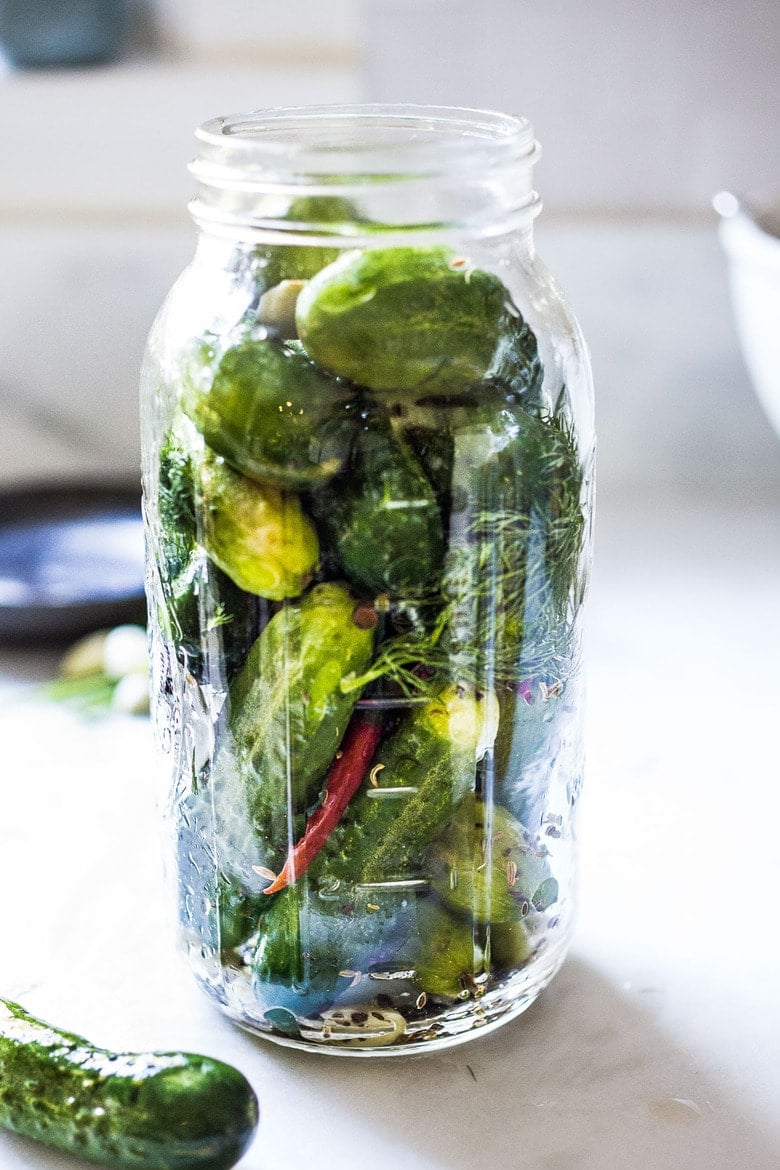
Step 4: Carefully measure and mix salt and water to create the 3% salt water brine- then pour this brine over the pickles leaving 1 1/2 inches of headroom.
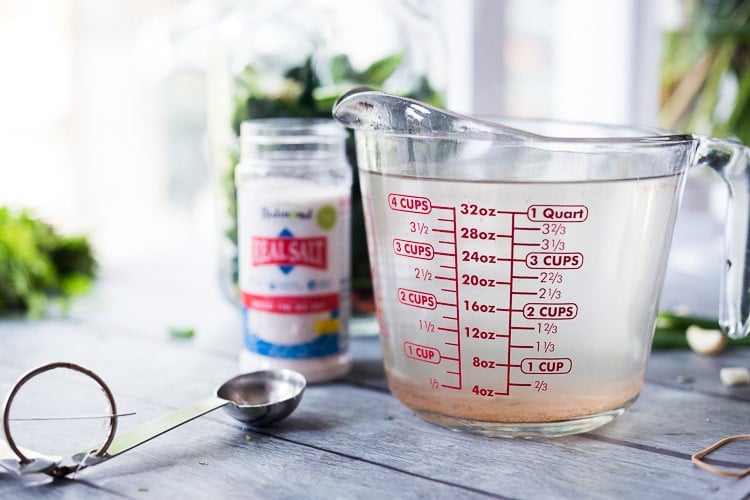
How salt works in fermentation:
- In a nutshell, using the right ratio of salt in fermentation encourages the growth of healthy bacteria while at the same time killing off bad bacteria. You want to be precise when measuring the salt and water in these kinds of recipes.
- Too much salt may kill off ALL of the bacteria -preventing fermentation.
- Too little salt will allow bad bacteria to keep on living. It is a fine balance. 😉
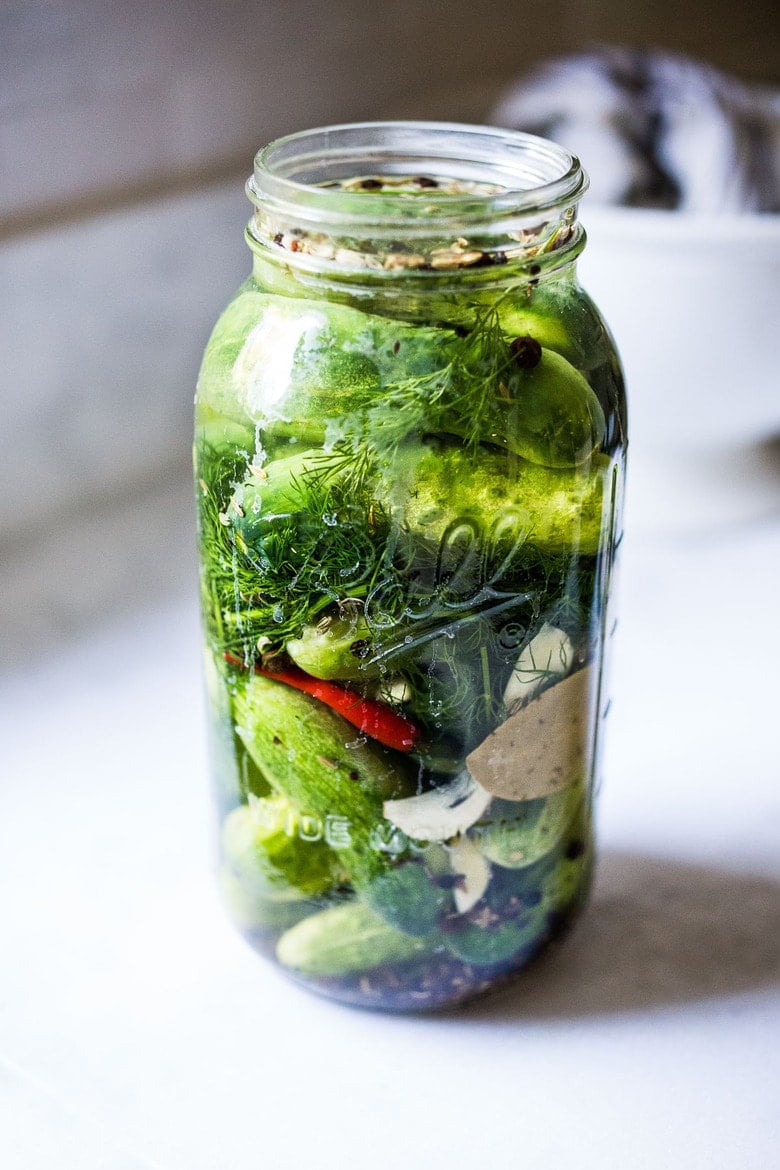
Step 5: Weigh down the cucumbers so they are completely submerged under the liquid, using a couple of fermentation weights, or a small zip lock bag filled with a little water (in a pinch).
MOLD: If the cucumbers or seeds are not submerged under the brine and become exposed to air- they can develop mold, so spoon any floaters out with a slotted spoon. Most seeds should stay submerged.
Step 6: Cover loosely with a lid or towel (to prevent bugs or flies from coming in, and to allow gases to escape) place in a bowl or pan to catch any overflow, and place in a cool dark place for 3-7 days, like the basement. You can also use and airlock lid- which allows air to escape, but nothing to fly in.
Step 7: Check after 2-3 days. Look for signs of life: bubbles/ or cloudy water. A cloudy brine is GOOD. Tap the jar and see if bubbles rise to the top. Check to see if any brine overflowed into the bowl ( both signs of life). This often takes about 3-5 days, I find 4 days is the “sweet spot”, depending on temperature. Cloudy brine is delicious and nutritious!
Step 8: Place the jar in the fridge to further slow the fermentation with a loose lid. They will continue to ferment very slowly and will keep indefinitely.
Expert Tips:
- Ferment at cooler temps (60-70F) to keep pickles crisp. If your home is hot, try placing in a cooler with ice. Take the temp of the brine.
- The longer you ferment them (unrefrigerated), the tangier they will get. But they will also get softer. I like them crisp, but you may want them tangier and softer. You can taste them at any point after you see bubbles.
- Smell: your ferment should smell tangy, garlic and fresh. If you notice anything foul or unpleasant, your ferment may have been contaminated: most commonly by dirty hands, dirty utensils, or a dirty jar.
- If you want to create a “fizzy” brine for drinking, tighten the lid, and burp daily if leaving out. You can tighten the lid in the fridge, but burp weekly. This will create a little pressure and give it some effervescence.
- Anything that touches air- may mold. Always fish out any floating spices with a slotted spoon to prevent this.
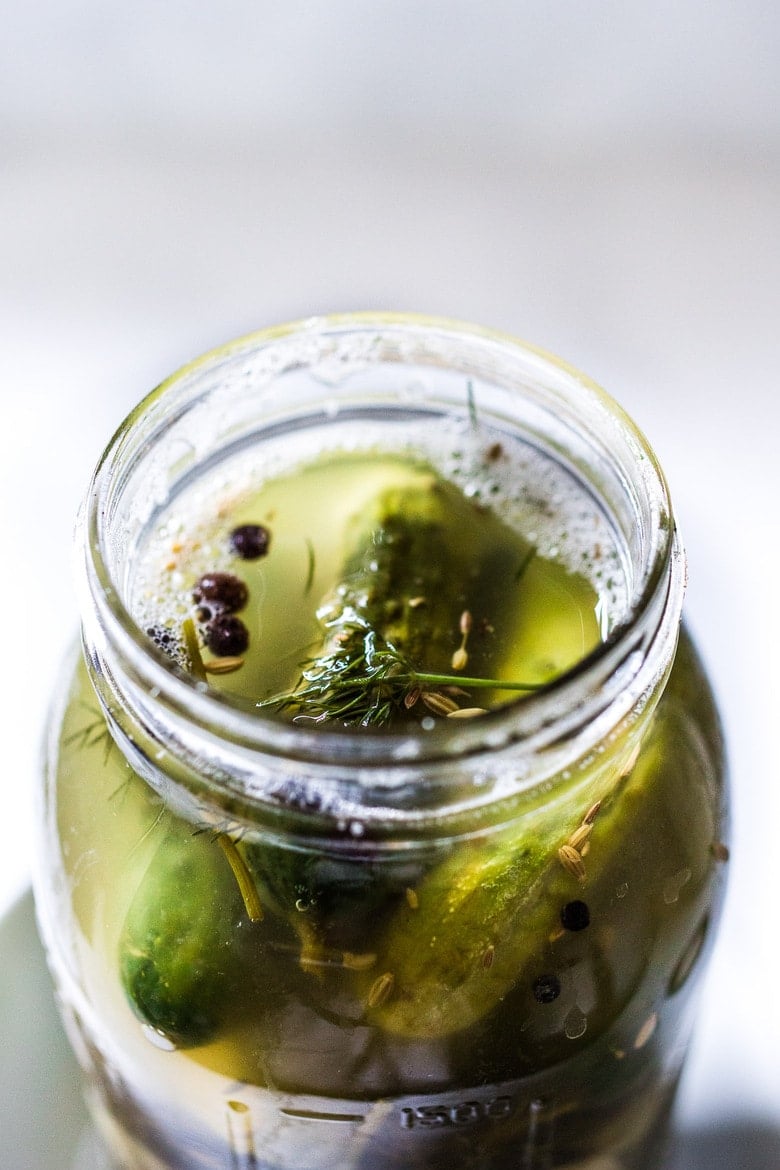
Once they are cold, give them a taste. They should be crunchy and flavorful! The brine is deliciously tangy, salty, and effervescent -so tasty and full of gut-supporting probiotics. The garlic is tasty too! Eat it!
I find myself often drinking shots of the brine! I also make this Gin & Brine Martini!
Let me know how you like this one in the comments below!
xoxoxo
More Favorite Ferments!
- Curtido & Cultured Salvadoran Slaw
- How to make Sauerkraut (Simple Cultured Cabbage)
- Beet and Cabbage Sauerkraut
- Cucumber Kimchi Pickles
- Turmeric Sauerkraut
More from Feasting at Home
How to make Fermented Pickles| 45-sec video
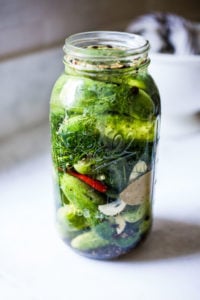
Homemade Pickles with Garlic and Dill
- Prep Time: 4 days
- Total Time: 4 days
- Yield: ½ gallon
- Category: fermented, preserved
- Method: fermented
- Cuisine: American
- Diet: Vegan
Description
How to make Manhattan-style, fermented Dill Pickles! A simple recipe for making the most flavorful, crunchy, tangy, garlic dill pickles with only 15 minutes of hands-on time. Full of healthy, gut-healing probiotics these little guys are perfect as a low-calorie snack, or sliced and added to sandwiches.
Ingredients
- 2- 2 1/2 lbs pickling cucumbers– all similar size ( 5 inches)
- 5 cups filtered water or tap water (that is not overly chlorinated)
- 2 tablespoons fine sea salt or Himalayan salt — or basically one heaping teaspoon fine sea salt (7 grams) per one cup of water, for a 3% brine (see notes)
- 1/4 teaspoon turmeric (optional, adds a “fresh” flavor)
- 1 teaspoon each: fennel seeds, coriander seeds, allspice, peppercorns, dill seeds, mustard seeds, celery seeds- and feel free to add more peppercorns!
- 10-20 garlic cloves, sliced (or double for extra garlicky)
- 1/2 onion, thinly sliced (optional)
- big handful of fresh dill
- 1-3 fresh red chilies – or dried arbol chilies, or add chili flakes (all optional)
- 3-4 bay leaves (or a grape leaf or oakleaf) – these are sources of tannic acid to help them stay crisp.
Instructions
- Prep Cucumbers: Rinse the cucumbers, remove 1/16-inch of the flower end of each cucumber (keeps them from getting soft) and place them in an ice-water bath, to crisp them up (15-30 minutes). Leave them whole.
- Make the brine: Mix salt (2 tablespoons) and 5 cups cold water until dissolved.
- Wash your hands, jar and any utensils. No need to sterilize, just clean!
- Assemble: In a large, clean two-quart mason jar, place all the whole spices into the bottom. Add the dill, garlic and onions or turmeric if using. With clean hands, pack one layer of cucumbers tightly, standing on end, then add the bay leaves, then add the second layer of cucumbers standing on end.
- Press everything down, leaving 1 ½ inches of headroom. Pour the salt water brine over the top and weigh down the cucumbers with fermentation weights so they are submerged under the brine. Remove any spices that may have floated to the surface (which can mold).
- Cover the jar loosely with a lid or with a cloth- basically, the pickles will bubble and you want air to be able to escape.
- Place the jar in a pan or bowl to collect any overflow and leave it in a cool dark place (60-70F) for 2 -3 days (a basement, or lower kitchen cupboard) and check for bubbles or overflow, indicating fermentation. Half sour pickles will take 3-5 days with crisp, white interiors. If is colder than 65F, it may take longer, if hotter, they will ferment faster. Full sour pickles will take 14-21 days (see notes for a stronger saltwater ratio).
- After 2 days, check for signs of life: bubbles, overflow, or clouding. Tap the jar, and see if tiny bubbles rise to the top. I usually ferment for 3-5 days. Longer ferments will yield tangier pickles but will get softer as they ferment, and lose their vibrant color. Up to you. You can taste them at any point after you see bubbles, and ferment longer if you like. The brine will get cloudy as it ferments- this is a good sign! Once you see active bubbles, you can at this point place the jar in the fridge, where it will continue to ferment, but much more slowly. Keep the pickles submerged.
- Once chilled, give them taste. They should be crispy and flavorful with a little tang. (At this point, if you want a tangier or softer pickle, you can absolutely pull them back out again and ferment for a few more days longer if you want.)
- If you like fizzy brine, tighten the lid, burping every week or so or try using an airlock. If you don’t want to think about it, give the lid one loose twist, so it’s on there, but gases can escape.
Notes
If you need more brine, make sure you use the same ratio- 1 heaping teaspoon sea salt per one cup of water.
If using a grape leaf, place it on the side of the jar, then layer the remaining ingredients.
If pickles turn out too soft- it may be due to too warm of temperature during fermentation, or the flower end wasn’t removed (the flower end of the cucumber has enzymes that can soften pickles).
Feel free to use 2, quart-size jars, dividing cucumbers, spices and brine between the jars.
BRINE: This recipe is a 3% salt water brine, which is considered “safe”. It equals 7 grams of salt per one cup of water. I’ve had really good luck with this ratio – and this ratio allows me to drink the brine (like a shot) this is really healthy – full of good gut-supporting bacteria!
If you want a stronger, saltier brine, feel free to go up to 4.5%. For a full sour pickle (14-21 days) use a 4.5% brine.
- 3% ratio = 7 grams salt per 1 cup of water. (1 1/4 teaspoon fine sea salt, per 1 cup water)
- 3.5% Ratio= 9 grams of salt per 1 cup of water. (1 1/2 teaspoon fine sea salt, per 1 cup water)
- 4.5% ratio 10.8 grams of salt per 1 cup of water. (2 teaspoons per cup of water)
Cutting the Cucumbers: I recommend leaving them whole. The texture is much better. After your first successful batch, feel free to experiment.
Nutrition
- Serving Size:
- Calories: 16
- Sugar: 1.3 g
- Sodium: 297.4 mg
- Fat: 0.2 g
- Saturated Fat: 0 g
- Carbohydrates: 3.7 g
- Fiber: 0.5 g
- Protein: 0.7 g
- Cholesterol: 0 mg
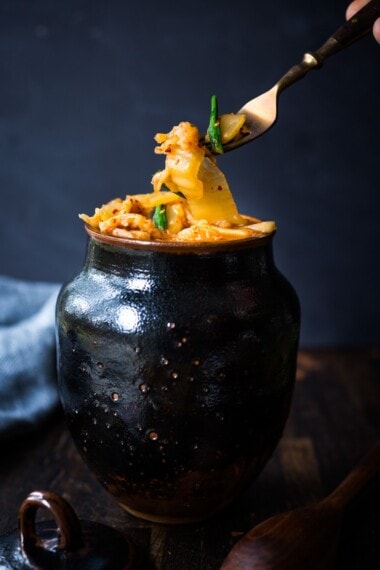
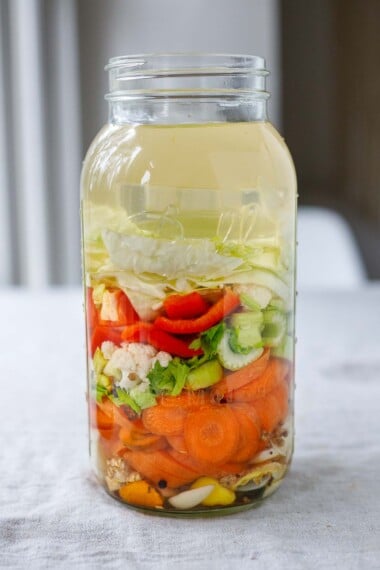
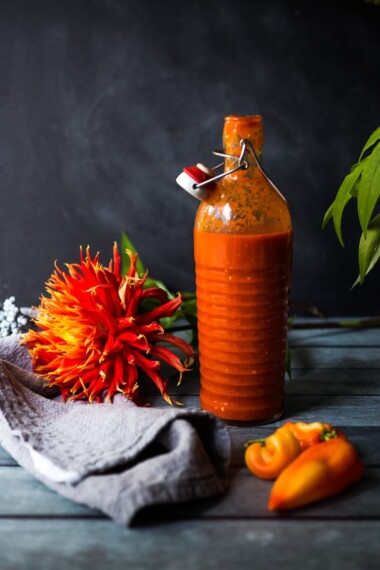
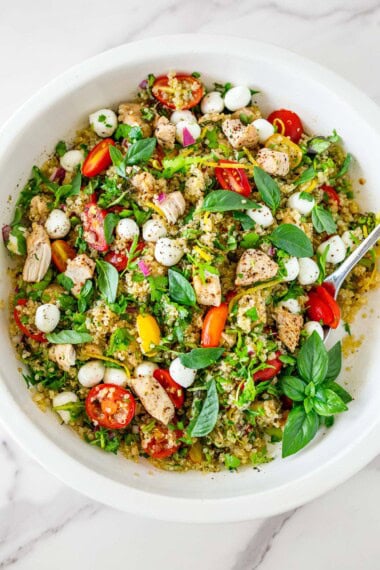
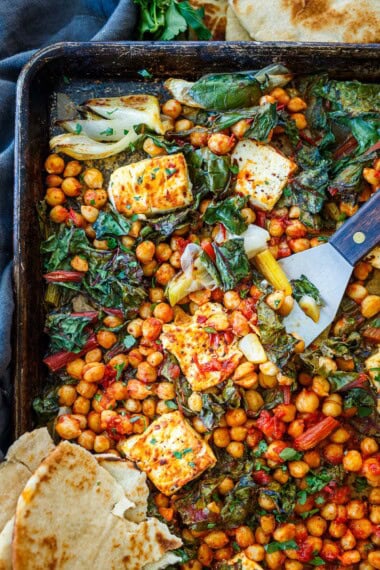
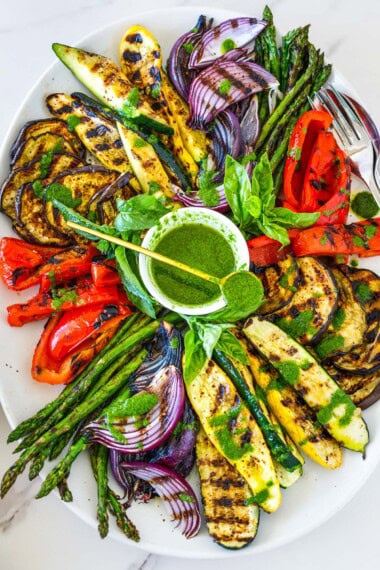



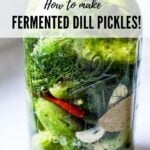
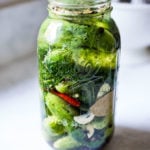
Im confused about ratio. In the beginning you said 2 tablespoons of salt, then it want to 1 teaspoon? Which is correct?
Hi Kathy, It is one heaping teaspoon per cup of water. 2 tablespoons for the entire recipe which calls for 5 cups. Does that make sense?
2 Tablespoons for 5 cups water or 1 teaspoon per cup of water. 1 teaspoon/cup is slightly more salt.
I found a 1.5 liter Mason jar of my home-made fermented pickles in the dark deep of my cupboard that I made apx 10 years ago, when moving. Jar us unopened, and look great. I am afraid to open, but curious if they are still good? How long can you keep fermented pickles unopened in the dark and how do you know if they are still safe to eat?
Wow, I don’t know the answer to this Petra! I would be tempted to try them if they smell good and look good.
I have had a terrible time growing dill this year. Can I use dried dill seed instead of fresh dill? Also, how much of that would I need?
I haven’t made it with dried but here is what I would try: per quart- 1 teaspoon dill seed or 1 tablespoon dried dill.
Thanks so much- helpful!
Will dry bay leaves work for this recipe?
Yes Vicki, dry bay is great.
I made too many of these last summer and they still sit in my fridge. Have any ideas on what I can make them into? We don’t really use relish. Maybe some sort of dip?
I like adding them to tartar sauce, potato salad, deviled eggs, etc. A dip would be fun to play around with- pickle hummus??
Potato salad.
Boil Russet potatoes in the skin just before they start cracking. Remove and dump in to cold water. Wait few minutes until a little cool and peel off the skin. Do not peel off the skin before because all the flavors going to be gone. Cut in to small cubes. Add mayo, ground pepper, hard boiled eggs also cut in to small pieces (optional). Chop a few pickles (cubed) and throw them in. Do not add salt because pickles are already salted. Also, cooked meat like strips of chicken is optional. Or cubed baloney. Chopped green onions also good.
Yum!
I recently saw a recipe for potato latkes by Carolina gelen. I haven’t tried them yet ,but they look delish. I’m hoping to make some as soon as my pickles are finished fermenting!
Did you put vinegar in it? They are still good pickles so you can use them in potato salad, sandwiches, and any other stuff where you want a little salt but not the actual salt.
Pickle de gallo salsa.
Hi there!
I can’t find any pickling cucumbers at my local stores. Can I use regular cucumbers? I’d have to cut them to fit in the jar.
Hi Kim, I do not recommend using regular cucumbers, they just won’t ferment as well with the waxy skin.
I agree. I’d suggest looking in small specialty markets. I found mine in a Turkish market in town. Maybe Whole Foods in the U.S.?
Yes, perhaps, but tough to find here now… they are just not in season now. Easy to find June-Sept. 🙂
Try Switzerland for out-of-season items? There are places that get hot-house cukes but maybe it’s okay to keep our special pickles to in-season treats. A great recipe worth keeping forever!
Here in LA they are always available somewhere. Maybe not at a good price but always.
You are lucky!
Hi Sylvia
Noting not use use regular cucumbers. What about the mini one’s? Very hard to find here as well winter season.
Will try and if all fails I at least tried and know better for next time.
I want to make Polish pickle soup but maybe at pickles in the store are made with vinegar and the soup that I make is made in brine. So I looked up your recipe.
Fingers crossed 🤞
Hi Tammy, I’ve tried with mini cucs as well, and the thin skins are not ideal for this. It may be ok for your soup though? Just not for longer storage.
followed the recipe placed the pickles in a dark basement to ferment. Five days later the brine is cloudy but no bubbles. Not sure where to go from here should i refrigerate now or hold off and wait for bubbles?
Hi Susan! I bet they are probably good to go! You can refrigerate. Give them a taste; if you want them tangier, you can always pull them out and let them ferment a couple of days longer. 🙂
It’s day 2 && I noticed a couple of my jars have bubbled over & my cucumbers are not fully submerged. Would making more brine and topping off be a good idea?
Hey Kelsey! They sound happy! Can you sink them down under the current brine level? If not, yes you can add more brine, to get them under, so they don’t mold.
Get a dill bunch and put it on top. This will push cucumbers down.
Looking forward to try this recipe! Can you only pickle cucumber or more veggies? And is the brine safe to drink or reuse somehow?
Hi Emilio- yes you can drink the brine, it is delicious! Check out our Gut Shot Recipe for more ideas!
When I put my done jars in the fridge, do I need to keep the pickles submerged with the glass weights to prevent mold or will the cold prevent any mold? Can I remove the weights and just use screw lids? (with plenty of brine)
If the pickles cured under the brine they will be fine in the fridge without the weight.
This is the second time making this recipe and last year’s were fabulous. I prefer using the smaller pickling cucumbers but here in Switzerland there’s a very short season for them. For this batch, they seem a little larger than usual. So, the question is, after they’ve fermented, can I cut them in pieces and return them to the brine without causing them to soften?
Also, I had eaten them at a spa and they kindly gave me their recipe, but without all the guidance you’ve provided. The one major difference in ingredients is that they add a small amount of sugar. A friend said she’s heard of adding honey. Anybody tried this? (I want the real NY deli puckering good and crunchy style).
Thanks again for a great recipe!
Hi Lesie- so happy you are enjoying this. I would experiment- just cut one of the cucumbers and see what you think? Adding a little sugar is fine too- it rounds out the sourness if that is what you want.
Excellent recipe. I used 3% brine with thick slices of cucumbers I grew. They are excellent.
Glad you gave it a try!
This recipe is amazing! I made a 4% brine and fermented for 2 weeks. They are delightful and the brine is also really good. Thanks for sharing. Im looking forward to trying your other recipes!
So happy you enjoyed this Emily!
Can you waterbath process them once they have fermented? If so, do you keep the same brine? I made 5 jars amd don’t have the fridge space to keep them. Thanks
Hi Leah, this is not a canning recipe- you’ll kill all the healthy probiotics if you process in a water bath.
I have pre-mixed my pickling spices in a mason jar … suggestions on how much to add instead of individually? The mix is the same as the ingredients you listed! Thank you!
Hi Christi- this should work great- how big is your jar?
Hi! Its a one gallon with an airlock.
I would add 4 tablespoons! 1 tablespoon per quart. 🙂
Once they are fermented, how long will they keep in the fridge? My Baba made her pickles like this and they were my favourite. I can’t wait to try them!
Hi Chrissy, once in the fridge they will keep indefinitely! The will soften up over time so I like to make smaller batches and consume within 2 weeks for that great crunch!
We made the pickles before leaving for a 4 day vacation and found that some seeds had floated to the surface and developed some white mold while we were gone. The brine looks good and bubbly. Could it be safe to remove the mold and taste the pickles or should we throw this whole batch out and start over again? Thank you!
Hi Alex, there are two camps here. Some believe it’s fine to remove and discard the mold- and feel free to try this ( smell and taste). I used to be in this camp, but now I shifted to the other camp- and if it were me, I would start over. I know it is kind of heartbreaking…
I am 66 years old, my mother who passed away 24 years ago used to make pickle all her life. I made pickles all my life. There is always mold on top of the pickles. Just remove it. I put dill on top of the jar to keep the pickles down so a lot of mold settles on that. But if the mold gets on the pickle just wash it off.
We are going on vacation and will only be able to leave the pickles out to ferment for 2 days. Can I refrigerate them after 2 days and then set them out again for a few more days when I get back?
Yes, that should work great!
I got brave enough to try fermenting for the first time last year bc we had an abundance of hot peppers and didn’t know what to do with them. When I found your fermented hot sauce recipe it looked too good not to try. It was so easy and turned out soo good so we decided to branch out this year and make these pickles too. They are absolutely divine! Your recipes for fermenting are so easy to follow and approachable for a newer fermenter like me. I will make these every year now!
So glad to hear this Mandy!
Excellent recipe – my very first attempt turned out great!
Awesome Peter!
First time making pickles this way – and we loved them.
On to our 2nd batch, but only have qt and pt sized jars left.
May experiment with quartering the cukes….
Let us know how it goes!
What kind of “bubbles” should I expect? It’s been 2 days and if I tap I get a few teeny tiny air bubbles. Is that the right kind of bubbles, should I leave them un-refrigerated another day? This is my first year to try my hand at making pickles. 😊
Yes, tiny bubbles that float to the top when you tap the jar. One more day wouldn’t hurt them!
Hey! Excited to get this recipe. How long would these pickles last if they remained closed in a cool dark place? I don’t have a ton of fridge space but I’m a confident canner but was unsure if canning them would just ruin the pickles making them soft.
Hi Tyler, canning will kill the fermentation, and kind of misses the point of doing this in the first place- having all those alive healthy probiotics for you gut! They can continue to ferment in a cool dark place- but will get really soft and sauer after a few weeks. If you are more about preserving, than the probiotics, then I’d can them, these fermented ones are best stored in the fridge.
Thanks for replying. This is always the conundrum for me. I grow way more pickles than I could fit in my fridge – I guess I do a few jars of these as I love all the benefits and the figure out how to perserve the others as best I can – thanks
Yes, that is what I would do!